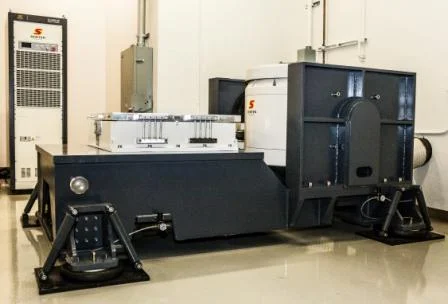With the development of multiple shaker table systems, the availability of Multiple Input Multiple Output (MIMO) controllers and Multiple Input Multiple Output (MIMO) vibration control started emerging a couple of decades ago. Due to the readiness of standards, (e.g., Mil STD 810G, Method 527 and IEST DTE 022 working group recommendation) MIMO Testing has gained a huge momentum in the past decade. The increased usage of multiple shaker testing systems has been adopted by not only our military and defense industries, but also NASA, automotive, and many other commercial industries as well.
Read moreComparison of Multi-Resolution Spectrum Technology and Regular FFT in Modal Analysis
Modal testing and analysis are crucial processes in the product development cycle. Sometimes the testing results are wrong by several magnitudes, especially in the low frequency bands where the frequency resolution is not sufficient. Crystal Instruments’ patented Multi-Resolution (MR) Spectrum technology helps overcome this issue with a unique solution. A modal test is carried out to examine data obtained through regular FFT technology and MR technology to quantify the modal results, such as damping, FRF amplitude, Auto-MAC chart, and mode shapes.
Read moreMultiple Shaker Table Systems
There are many different shaker table arrangements based on various types of MIMO testing applications. The Multiple Shaker Table System ranges from Multiple Exciter Single Axis (MESA) to Multiple Exciter Multiple Axis (MEMA) with 2 to 6 shakers involved (e.g., three axis translational shaker table, four-poster, 6 DOF Multi Axis Shaker Table (MAST), etc.)
Read moreOutput Ground Isolator
The output ground isolator is the most user-friendly solution for controlling multiple shakers while simultaneously improving accuracy of control and ensuring safe operation.
Read moreMulti-Resolution Spectrum Analysis and Sine-on-Random Testing
In this blog post, we will discuss the benefits of using Multi-Resolution, a feature available in Vibration Control Systems, to offer a better frequency resolution in the lower frequencies of the Sine-on-Random vibration spectrum. The same benefits are also applied to the general Random test, and Random-on-Random mixed mode test.
Read moreSmart Battery Pack Testing with EDM
A battery pack has an enclosure to protect battery cells from external hazards, such as external forces and moisture. An internal cooling system and Battery Management System (BMS) provides a protected environment for the cells to perform in.
While performing vibration or THV (temperature/humidity/vibration) tests on a battery pack, accelerometers, temperature, and humidity sensors can measure the external environment of the battery pack. The BMS monitors the status of internal battery pack and communicates with external components via CAN bus.
Read moreVibration Testing Fully Connected Cars
Vibration testing of automotive components helps manufacturers ensure both a sound design and improved reliability. The current growing demand for electric vehicles has placed battery testing into the spotlight and as a result, attention for vibration tests of electric vehicle batteries has increased.
Read moreSwept Sine Test Measurement Strategy
A Swept Sine test is a type of vibration test where the controller excites one specific frequency via sinusoidal voltage drive. As opposed to a Random test, where a broadband of frequencies is excited together like white noise, the Swept Sine test produces a response with energy in the primary frequency and its harmonics (i.e., frequencies that are multiples of the primary frequency).
Read moreModal Testing with Shaker Excitation – What are some of the issues to consider? Webinar featuring Dr. Peter Avitabile
Join Crystal Instruments for a free webinar on March 29, 2021 at 8:00 am PDT featuring lead instructor Dr. Peter Avitabile, PE, University of Massachusetts Lowell.
Read moreVisualizing the Orbit Trace of a Three-axis Shaker
This section describes the orbit plot feature in the vibration visualization function. In-depth details about the workflow of the vibration visualization process will be discussed in the later portion of the article. The orbit plot is not only used to understand the magnitude of the vibration during a vibration test but also to observe the phase relationship between the different channels used to acquire the response of the unit under test. This is understood more clearly using a test case.
Read more

